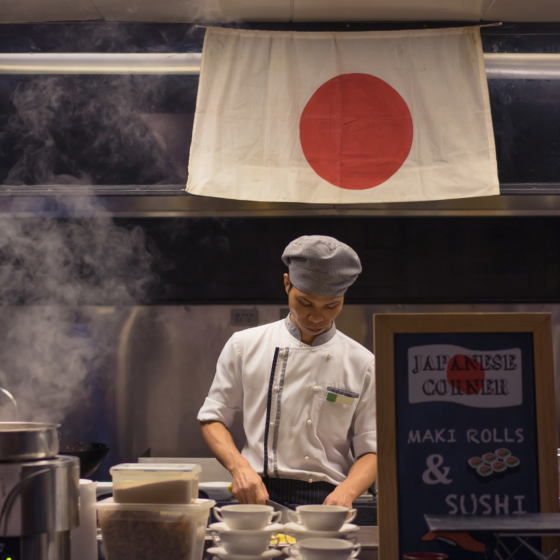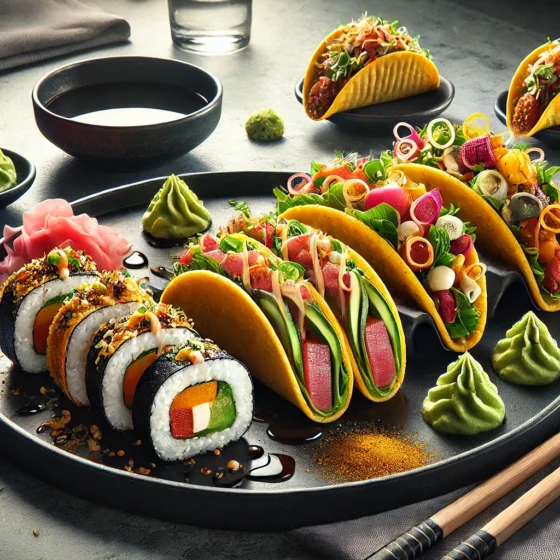Culinary tourism represents the intersection where travel meets the innate human desire to explore and indulge in new food experiences, serving not merely as a pursuit of eating but as a deeper dive into the essence of food culture across the globe. This phenomenon has become a pivotal aspect of travel, underlining the importance of food as a cultural signifier and a connector of people from different backgrounds. The exploration of global cuisines opens a window to understanding societal structures, traditions, and the evolution of foodways, positing food not just as sustenance but as a narrative of human civilization.The burgeoning interest in food tourism and food festivals further highlights the escalating value placed on culinary diversity and its impact on local tastes and economies.
This article aims to dissect the historical intricacies and driving factors behind the global influence of culinary practices on local food scenes. It will explore the mutual exchange of culinary traditions that has shaped food culture over centuries, identifying the key elements that spur the integration of global cuisines into local diets. The discussion will then pivot to the tangible impacts this integration has on local food landscapes, marked by the emergence of food festivals and a proliferation of international foodways in local markets. Lastly, it will prognosticate on the future trends in culinary integration, providing insights into how culinary tourism might continue to evolve and influence local and global food culture. By charting this journey, the article intends to offer a comprehensive understanding of culinary tourism’s role in the blending and preservation of global food traditions.
Historical Exchange of Culinary Practices
Early Trade Routes and Food
The Silk Roads played apivotal role in the historical exchange of culinary practices, introducing China to a variety of goods including fruits, crops, and spices through trade with Central Asian regions. Notably, during the Han and Jin Dynasties, nomadic peoples introduced crops such as carrots and cucumbers to China. This period also saw the introduction ofNang Bing, a type of flatbread, andBiluo, a translucent cake with varying fillings, showcasing the early impact of trade on gastronomy.
Colonial Imprints on Local Cuisines
Colonial periods further shaped culinary landscapes. The arrival of Jesuit missionaries in the Sonoran Desert introduced new seeds and livestock, significantly altering local diets. Similarly, in Mesoamerica, the Spanish colonization brought with it astark transformation in indigenous food systems, using food as a tool of colonization and introducing European foods into indigenous diets, while simultaneously marginalizing indigenous foods. This era marked a profound shift in culinary practices, emphasizing the role of colonization in the global culinary exchange.
Modern Migration and Culinary Fusion
Modern migration has continued to influence culinary practices globally. Fusion cuisines have emerged as a result of globalization and the blending of culinary traditions from different cultures. For instance, the California roll, a fusion dish created in Vancouver, illustrates theinnovative blending of Japanese and Western culinary traditions. This trend towards culinary fusion underscores the ongoing exchange and integration of global cuisines, reflecting the dynamic nature of culinary practices influenced by migration and cultural exchange.
This historical journey from ancient trade routes to modern migration highlights the continuous exchange and fusion of culinary practices, shaping global food culture and fostering a rich tapestry of culinary diversity.
Driving Factors Behind Global Culinary Influence
Role of Media and the Internet
The digital revolution, particularly social media platforms like Instagram, Facebook, and TikTok, has significantly impacted global culinary influence. Instagram,with its emphasis on visual aesthetics, has turned dishes into art, making Italian cuisine and other global foods more appealing worldwide. TikTok and YouTube have democratized culinary knowledge,offering quick, engaging content that encourages culinary creativity and exploration among users. These platforms have not only elevated food presentation but have also become catalysts for food trends, expanding culinary horizons and introducing global audiences to diverse flavors without leaving their local communities.
Travel and Migration
Immigrants play a crucial role in the global culinary landscape,carrying their culinary practices and habits across borders while acquiring new food customs. This bidirectional exchange reflects the human desire to share and dialogue through food. Moreover,the significant involvement of immigrants in the food system, from farming to serving in restaurants, underscores their contribution to the economic and cultural fabric of communities. Their culinary traditions, integrated into local scenes, enrich the global food culture, illustrating the profound impact of travel and migration on culinary influence.
Cultural Curiosity and Adventurous Palates
A growing interest in exploring diverse cuisines reflects a broader cultural curiosity and the desire for adventurous eating experiences. Food, as a universal language, offers a unique opportunity to learn about different cultures and traditions,fostering a sense of connection and broadening our understanding of the world. This curiosity drives food tourism,where individuals travel to sample unique dishes and flavors discovered through social media or personal encounters, further influencing local food scenes and integrating global culinary practices into local diets.
Impact on Local Food Scenes
Rise of Fusion Cuisine
Fusion cuisine, characterized bythe blending of ethnic flavors and ingredients from multiple culinary traditions, has significantly impacted local food scenes worldwide. This culinary approach, evolving from ancient trade and migration, facilitates the creation of innovative and distinctive dishes that cater to a broad spectrum of palates. By merging the best elements of various cuisines, chefs achieve a unique flavor profile that appeals to diverse tastes, thereby enriching the local culinary landscape. The popularity of fusion cuisine underscores its role in bringing diverse cultures together, highlighting both the similarities and differences in culinary traditions.
Mainstreaming of Exotic Ingredients
The global culinary movement has also led to the mainstreaming of exotic ingredients in local food scenes. Ingredients once considered foreign or unusual, such as turmeric, ginger, and even charcoal, are now integral to modern dining experiences. This trend not only broadens the flavor palette available to chefs and diners but also offers health benefits, as many exotic ingredients are known for their nutritional properties. The incorporation of these ingredients into local cuisines reflects a growing consumer desire for adventurous and health-conscious eating options.
Transformation in Dining Experiences
The impact of global cuisines extends beyond the menu, transforming overall dining experiences. Social media plays a crucial role in this transformation, enabling culinary enthusiasts to explore international dishes and trends. As a result,restaurants are diversifying their menus to cater to the adventurous palates of modern diners, incorporating flavors and techniques from around the world. This exploration not only enriches the dining experience but also fosters creativity and innovation within the kitchen, making every meal an exploratory adventure. The promise of discovering new flavors and dishes turns a simple meal into an immersive cultural experience, attracting a diverse clientele seeking culinary adventures.
Future Trends in Culinary Integration
Sustainable and Local Sourcing
Farm-to-table and local sourcing initiatives are gaining momentum, emphasizing the importance of connecting consumers directly with local producers. This approach not only supports local economies but also promotes sustainability byreducing the carbon footprint associated with long-distance transportation of food items. The adoption of technology, such as blockchain, is enhancing transparency in the food supply chain, allowing consumers to trace the journey of their food from farm to table. This trend towards sustainability and local sourcing is expected to continue, driven by consumer demand for freshness, quality, and environmental responsibility.
Technology in Dining
The integration of technology in dining experiences is transforming the restaurant industry. From streamlined ordering processes with tableside tablets to smart kitchen gadgets that optimize food preparation, technology is making dining more efficient and personalized. Additionally, advancements in restaurant technologies, includingAI-powered chatbots for customer service and IoT devices for food safety monitoring, are setting new standards for operational efficiency and customer engagement. As technology continues to evolve, its role in enhancing dining experiences and operational workflows in restaurants is expected to grow.
Hyperlocal Adaptations of Global Trends
The globalization of food trends, accelerated by technology, is fueling a movement towards hyperlocal adaptations. Online platforms and location-based services are making it easier for consumers to explore global flavors while supporting local dining experiences. This fusion of global trends with local culinary traditions is fostering a unique culinary landscape, where global flavors are adapted to reflect local tastes and ingredients. The drive towards sustainability is also influencing this trend, with restaurants and food producers increasingly prioritizinglocally sourced and seasonal ingredients to offer a taste of the local terroir.
This blend of global influences with local adaptations highlights the dynamic nature of culinary integration, where technology, sustainability, and cultural authenticity converge to shape the future of dining and food production.
Conclusion
Throughout this exploration of culinary tourism, we’ve delved into the fascinating interplay between local tastes and global cuisines, illuminating how food acts not only as a means of sustenance but as a vibrant narrative of cultural exchange and evolution. The historical journey from ancient trade routes to contemporary fusion cuisine underscores the enduring influence of migration, media, and an adventurous spirit on our dining tables. This narrative has highlighted the significance of culinary tourism in fostering an appreciation for diverse food traditions, promoting economic growth, and creating a global tapestry of shared tastes and experiences.
As we look to the future,the growing trends of sustainability, technology in dining, and hyperlocal adaptations point towards a more interconnected yet individually tailored culinary landscape. These movements not only promise exciting possibilities for the confluence of global and local flavors but also underscore the role of culinary tourism in championing environmental responsibility, cultural authenticity, and innovative dining experiences. Culinary tourism, thus, stands at the crossroads of tradition and innovation, inviting us all to explore the world one plate at a time, while appreciating the deep-rooted connections that food weaves amongst us.
FAQs
What makes food tourism crucial for local communities?
Food tourism significantly contributes to the preservation of local heritage and innovation while enhancing existing tourism attractions. It boosts the demand for local food and beverages, which in turn supports the sustainability of local agriculture, food systems, communities, and culture.
How does culinary tourism impact local communities?
Culinary tourism primarily benefits local businesses and events economically. Additionally, it plays a vital role in promoting a sense of cultural belonging among local residents through local culinary experiences and food products.
In what ways does culinary tourism enhance local identity?
Culinary tourism fosters a connection between local culture and agriculture, encouraging the integration of slow tourism, which can extend visitors’ stays. This synergy between culinary and slow tourism strengthens local identity and culture.
What role does local cuisine play in boosting tourism?
Local cuisine is pivotal in defining a region’s identity and in the promotion of tourism. By focusing on culinary tourism, regions can promote environmentally sustainable practices, rejuvenate local heritage, and stimulate local economies.










